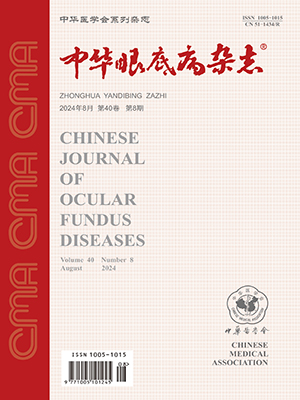| 1. |
颜华.我国眼外伤救治现状与面临的挑战[J]. 中华眼科杂志, 2015, 51(8): 561-564. DOI: 10.3760/cma.j.issn.0412-4081.2015.08.001.Yan H. The challenge and present condition of management of ocular trauma in China[J]. Chinese Journal of Ophthalmology, 2015, 51(8): 561-564. DOI: 10.3760/cma.j.issn.0412-4081.2015.08.001.
|
| 2. |
Kuhn F. The timing of reconstruction in severe mechanical trauma[J]. Ophthalmic Res, 2014, 51(2): 67-72. DOI: 10.1159/000351635.
|
| 3. |
Coleman DJ. Early vitrectomy in the management of the severely traumatized eye[J]. Am J Ophthalmol, 1982, 93(5): 543-551.
|
| 4. |
de Juan E Jr, Sternberg P Jr, Michels RG. Timing of vitrectomy after penetrating ocular injuries[J]. Ophthalmology, 1984, 91(9): 1072-1074.
|
| 5. |
Ryan SJ, Allen AW. Pars planavitrectomy in ocular trauma[J]. Am J Ophthalmol, 1979, 88(3 Pt 1): 483-491.
|
| 6. |
Dalma-Weiszhausz J, Quiroz-Mercado H, Morales-Cantón V, et al. Vitrectomy for ocular trauma: a question of timing[J]. Eur J Ophthalmol, 1996, 6(4): 460-463.
|
| 7. |
Mieler WF, Mittra RA. The role and timing of pars planavitrectomy in penetrating ocular trauma[J]. Arch Ophthalmol, 1997, 115(9): 1191-1192.
|
| 8. |
Cleary PE, Ryan SJ. Vitrectomy in penetrating eye injury: results of a controlled trial of vitrectomy in an experimental posterior penetrating eye injury in the rhesus monkey[J]. Arch Ophthalmol, 1981, 99(2): 287-292.
|
| 9. |
Nashed A, Saikia P, Herrmann WA, et al. The outcome of early surgical repair with vitrectomy and silicone oil in open-globe injuries with retinal detachment[J]. Am J Ophthalmol, 2011, 151(3): 522-528. DOI: 10.1016/j.ajo.2010.08.041.
|
| 10. |
Bajaire B, Oudovitchenko E, Morales E. Vitreoretinal surgery of the posterior segment for explosive trauma in terrorist warfare[J]. Graefe's Arch Clin Exp Ophthalmol, 2006, 244(8): 991-995. DOI: 10.1007/s00417-005-0186-1.
|
| 11. |
Ferreira N, Monteiro S, Meireles A, et al. Outcome of vitrectomy and chorioretinectomy in perforating eye injuries[J]. Ophthalmic Res, 2015, 53(4): 200-206. DOI: 10.1159/000371494.
|
| 12. |
Agrawal R, Shah M, Mireskandari K, et al. Controversies in ocular trauma classification and management: review[J]. Int Ophthalmol, 2013, 33(4): 435-445. DOI: 10.1007/s10792-012-9698-y.
|
| 13. |
Aylward GW. Vitreous management in penetrating trauma: primary repair and secondary intervention[J]. Eye(Lond), 2008, 22(10): 1366-1369. DOI: 10.1038/eye.2008.74.
|
| 14. |
Mansouri MR, Tabatabaei SA, Soleimani M, et al. Ocular trauma treated with pars planavitrectomy: early outcome report[J]. Int J Ophthalmol, 2016, 9(5): 738-742. DOI: 10.18240/ijo.2016.05.18.
|
| 15. |
Globocnik Petrovic M, Lumi X, DrnovsekOlup B.Prognostic factors in open eye injury managed with vitrectomy: retrospective study[J]. Croat Med J, 2004, 45(3): 299-303.
|
| 16. |
Colyer MH, Weber ED, Weichel ED, et al. Delayed intraocular foreign body removal without endophthalmitis during Operations Iraqi Freedom and Enduring Freedom[J]. Ophthalmology, 2007, 114(8): 1439-1447. DOI: 10.1016/j.ophtha.2006.10.052.
|
| 17. |
Falavarjani KG, Hashemi M, Modarres M, et al. Vitrectomy for posterior segment intraocular foreign bodies, visual and anatomical outcomes[J]. Middle East Afr J Ophthalmol, 2013, 20(3): 244-247. DOI: 10.4103/0974-9233.114803.
|
| 18. |
Sandinha MT, Newman W, Wong D, et al. Outcomes of delayed vitrectomy in open-globe injuries in young patients[J]. Retina, 2011, 31(8): 1541-1544. DOI: 10.1097/IAE.0b013e31820840ef.
|
| 19. |
Feng K, Wang CG, Hu YT, et al. Clinical features and prognosis of eyeball rupture: eye injury vitrectomy study[J]. Clin Exp Ophthalmol, 2015, 43(7): 629-636. DOI: 10.1111/ceo.12534.
|
| 20. |
赵明贵, 张士红.急性开放性眼外伤患者早期玻璃体手术治疗的时机及临床效果[J/OL]. 中华卫生应急电子杂志, 2016, 2(1): 17-20. http://med.wanfangdata.com.cn/Paper/Detail/PeriodicalPaper_zhwsyjdzzz201601006. DOI: 10.3877/cma.j.issn.2095-9133.2016.01.006.Zhao MG, Zhang SH. Opportunity of early vitreous surgery and its clinical efficacy in patients with open emergency ocular trauma[J/OL]. Chinese Journal of Hygiene Rescue(Electronic Edition), 2016, 2(1)17-20.http://med.wanfangdata.com.cn/Paper/Detail/PeriodicalPaper_zhwsyjdzzz201601006.DOI:10.3877/cma.j.issn.2095-9133.2016.01.006.
|
| 21. |
陆骏麒. 开放性眼外伤患者玻璃体手术的时机选择[J]. 国际眼科杂志, 2016, 16(9): 1765-1767. DOI: 10.3980/j.issn.1672-5123.2016.9.46.Lu JQ. Opportunity of vitreous surgery in patients with open ocular trauma[J]. Int Eye Sci, 2016: 1765-1767. DOI: 10.3980/j.issn.1672-5123.2016.9.46.
|
| 22. |
张效房, 杨进献.眼外伤学[M].郑州: 河南医科大学出版社, 1997: 32-36.Zhang XF, Yang JX. Ocular trauma[M]. Zhengzhou: Henan Medical University Publishing House, 1997: 32-36.
|
| 23. |
Meier P, Wiedemann P.Massive suprachoroidal hemorrhage: secondary treatment and outcome[J]. Graefe's Arch ClinExpOphthalmol, 2000, 238: 28-32.
|
| 24. |
Martin DF, Meredith TA, Topping TM, et al. Perforating (through-and-through) injuries of the globe: surgical results with vitrectomy[J]. Arch Ophthalmol, 1991, 109(7): 951-956.
|
| 25. |
Spalding SC, Sternberg P Jr.Controversies in the management of posterior segment ocular trauma[J]. Retina, 1990, 10 Suppl 1: S76-82.
|
| 26. |
Colyer MH, Chun DW, Bower KS, et al. Perforating globe injuries during operation Iraqi Freedom[J]. Ophthalmology, 2008, 115(11): 2087-2093. DOI: 10.1016/j.ophtha.2008.05.013.
|
| 27. |
Feng K, Hu Y, Wang C, et al. Risk factors, anatomical, and visual outcomes of injured eyes with proliferative vitreoretinopathy: eye injury vitrectomy study[J]. Retina, 2013, 33(8): 1512-1518. DOI: 10.1097/IAE.0b013e3182852469.
|
| 28. |
Abrams GW, Topping TM, Machemer R. Vitrectomy for injury: the effect on intraocular proliferation following perforation of the posterior segment of the rabbit eye[J]. Arch Ophthalmo, 1979, 97(4): 743-748.
|
| 29. |
Tolentino FI, Liu HS, Freeman HM, et al. Vitrectomy in penetrating ocular trauma: an experimental study using rabbits[J]. Ann Ophthalmol, 1979, 11(11): 1763-1771.
|
| 30. |
Williams DF, Mieler WF, Abrams GW, et al. Results and prognostic factors in penetrating ocular injuries with retained intraocular foreign bodies[J]. Ophthalmology, 1988, 95(7): 911-916.
|
| 31. |
Thach AB, Ward TP, Dick JS, et al. Intraocular foreign body injuries during Operation Iraqi Freedom[J]. Ophthalmology, 2005, 112(10): 1829-1833. DOI: 10.1016/j.ophtha.2005.04.024.
|
| 32. |
Wani VB, Al-Ajmi M, Thalib L, et al. Vitrectomy for posterior segment intraocular foreign bodies: visual results and prognostic factors[J]. Retina, 2003, 23(5): 654-660.
|




